Aspects of Contracts and Negligence
VerifiedAdded on 2020/02/12
|18
|6280
|53
Report
AI Summary
This report delves into the principles of contract and tort law, focusing on the aspects of contracts and negligence in business. It outlines the essential elements required for forming a valid contract, differentiates between various types of contracts, and discusses the implications of negligence in business scenarios. The report also highlights the legal responsibilities of parties involved in contractual agreements and the concept of vicarious liability in tort law. Through detailed analysis and case studies, it aims to provide a comprehensive understanding of how these legal principles apply in real-world business contexts.
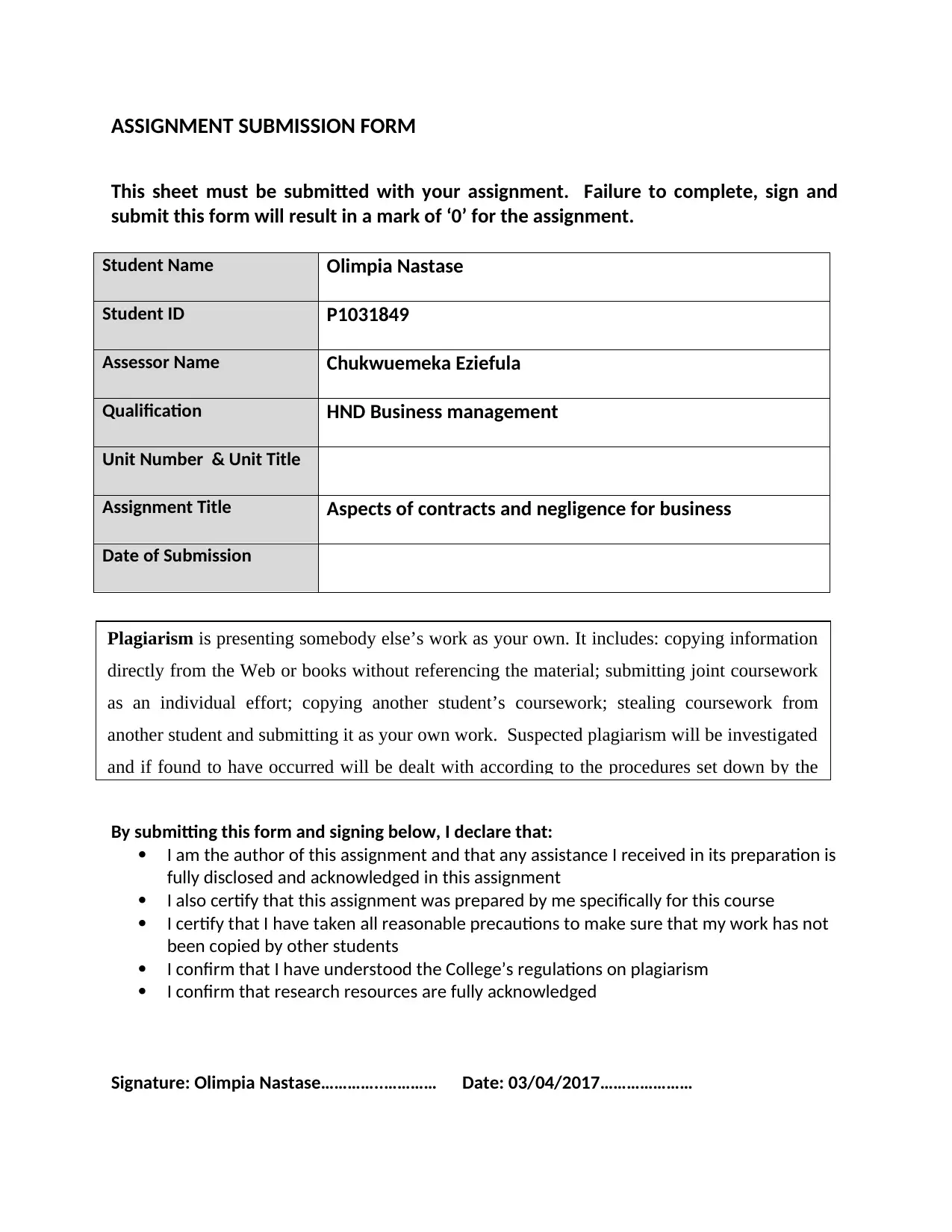
ASSIGNMENT SUBMISSION FORM
This sheet must be submitted with your assignment. Failure to complete, sign and
submit this form will result in a mark of ‘0’ for the assignment.
Student Name Olimpia Nastase
Student ID P1031849
Assessor Name Chukwuemeka Eziefula
Qualification HND Business management
Unit Number & Unit Title
Assignment Title Aspects of contracts and negligence for business
Date of Submission
By submitting this form and signing below, I declare that:
I am the author of this assignment and that any assistance I received in its preparation is
fully disclosed and acknowledged in this assignment
I also certify that this assignment was prepared by me specifically for this course
I certify that I have taken all reasonable precautions to make sure that my work has not
been copied by other students
I confirm that I have understood the College’s regulations on plagiarism
I confirm that research resources are fully acknowledged
Signature: Olimpia Nastase…………..………… Date: 03/04/2017…………………
Plagiarism is presenting somebody else’s work as your own. It includes: copying information
directly from the Web or books without referencing the material; submitting joint coursework
as an individual effort; copying another student’s coursework; stealing coursework from
another student and submitting it as your own work. Suspected plagiarism will be investigated
and if found to have occurred will be dealt with according to the procedures set down by the
This sheet must be submitted with your assignment. Failure to complete, sign and
submit this form will result in a mark of ‘0’ for the assignment.
Student Name Olimpia Nastase
Student ID P1031849
Assessor Name Chukwuemeka Eziefula
Qualification HND Business management
Unit Number & Unit Title
Assignment Title Aspects of contracts and negligence for business
Date of Submission
By submitting this form and signing below, I declare that:
I am the author of this assignment and that any assistance I received in its preparation is
fully disclosed and acknowledged in this assignment
I also certify that this assignment was prepared by me specifically for this course
I certify that I have taken all reasonable precautions to make sure that my work has not
been copied by other students
I confirm that I have understood the College’s regulations on plagiarism
I confirm that research resources are fully acknowledged
Signature: Olimpia Nastase…………..………… Date: 03/04/2017…………………
Plagiarism is presenting somebody else’s work as your own. It includes: copying information
directly from the Web or books without referencing the material; submitting joint coursework
as an individual effort; copying another student’s coursework; stealing coursework from
another student and submitting it as your own work. Suspected plagiarism will be investigated
and if found to have occurred will be dealt with according to the procedures set down by the
Paraphrase This Document
Need a fresh take? Get an instant paraphrase of this document with our AI Paraphraser
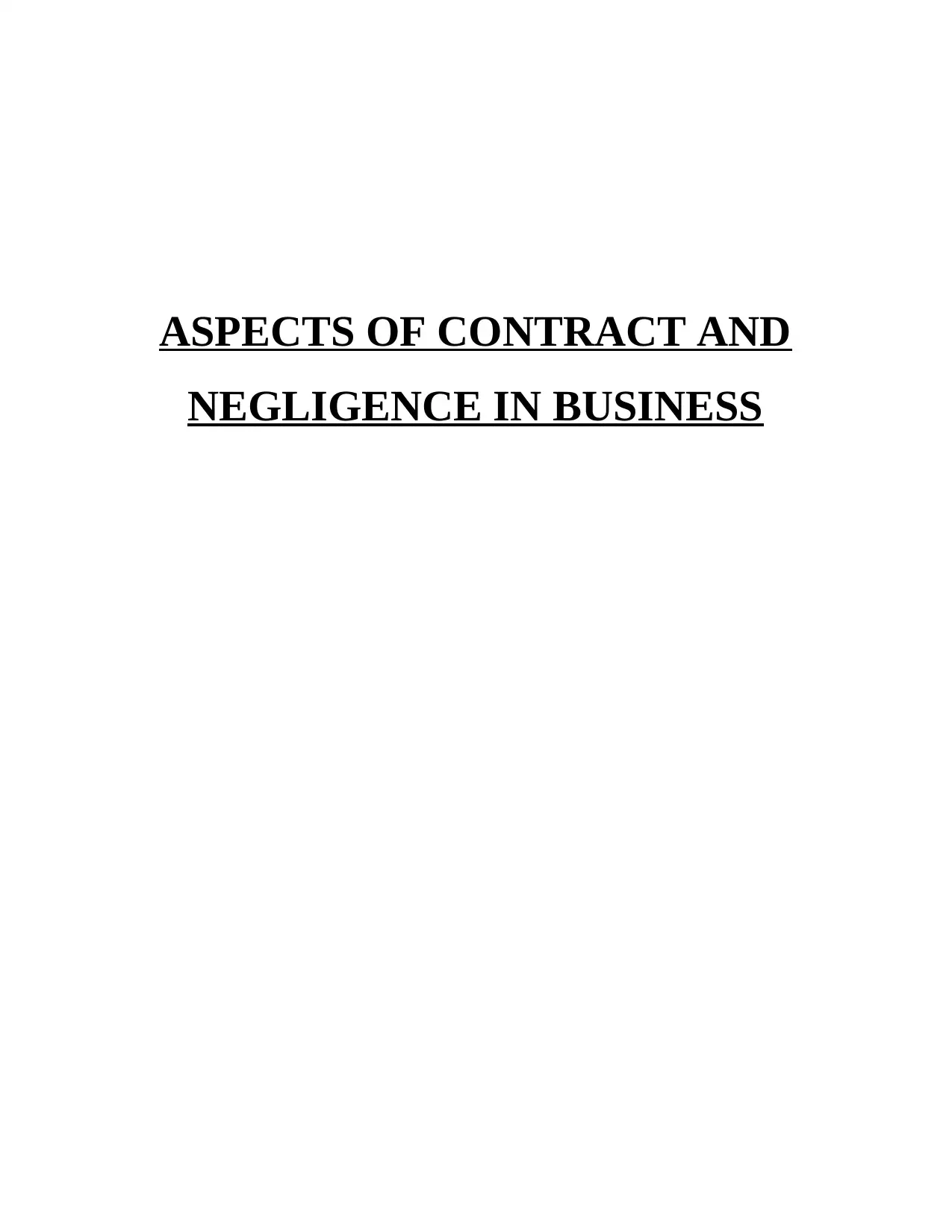
ASPECTS OF CONTRACT AND
NEGLIGENCE IN BUSINESS
NEGLIGENCE IN BUSINESS
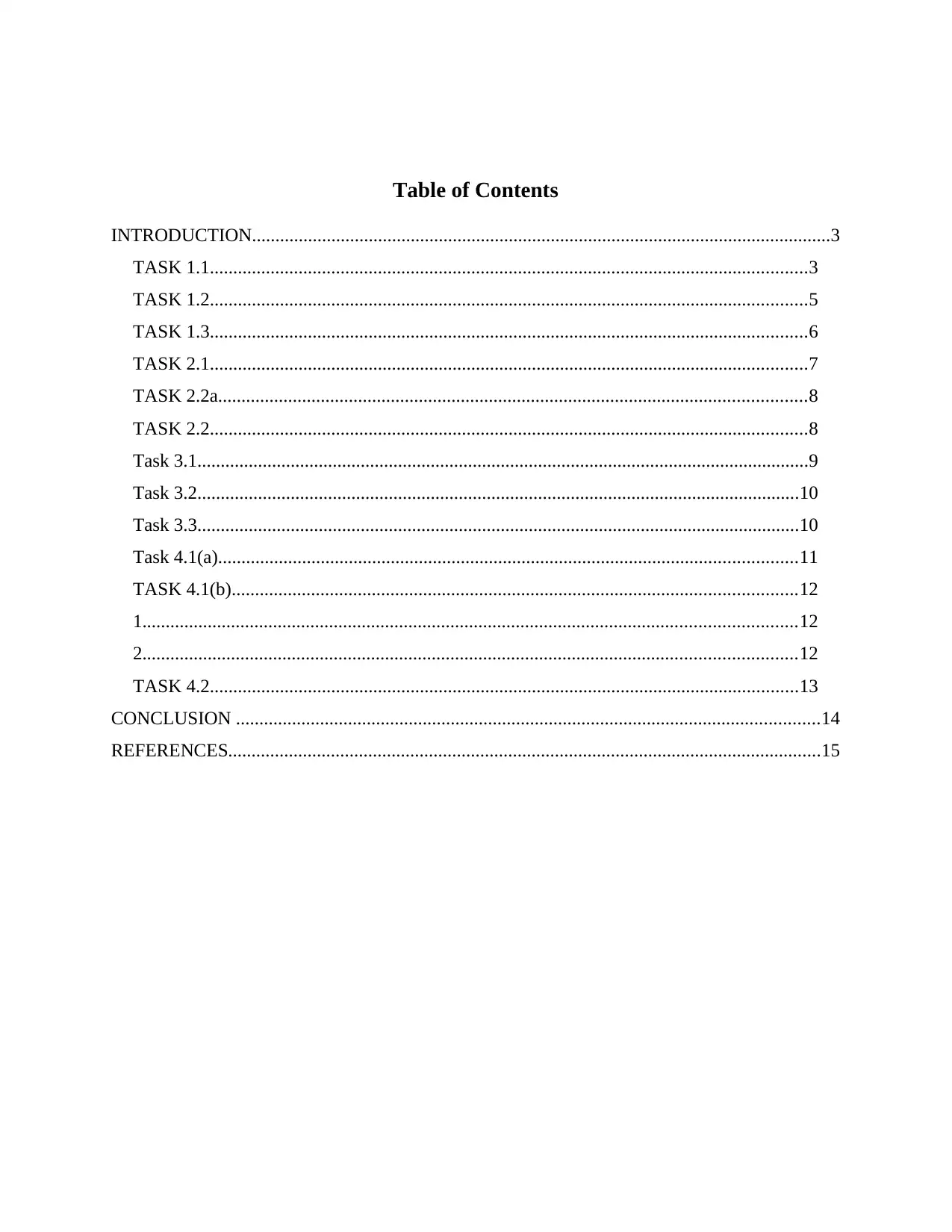
Table of Contents
INTRODUCTION............................................................................................................................3
TASK 1.1................................................................................................................................3
TASK 1.2................................................................................................................................5
TASK 1.3................................................................................................................................6
TASK 2.1................................................................................................................................7
TASK 2.2a..............................................................................................................................8
TASK 2.2................................................................................................................................8
Task 3.1...................................................................................................................................9
Task 3.2.................................................................................................................................10
Task 3.3.................................................................................................................................10
Task 4.1(a)............................................................................................................................11
TASK 4.1(b).........................................................................................................................12
1............................................................................................................................................12
2............................................................................................................................................12
TASK 4.2..............................................................................................................................13
CONCLUSION .............................................................................................................................14
REFERENCES...............................................................................................................................15
INTRODUCTION............................................................................................................................3
TASK 1.1................................................................................................................................3
TASK 1.2................................................................................................................................5
TASK 1.3................................................................................................................................6
TASK 2.1................................................................................................................................7
TASK 2.2a..............................................................................................................................8
TASK 2.2................................................................................................................................8
Task 3.1...................................................................................................................................9
Task 3.2.................................................................................................................................10
Task 3.3.................................................................................................................................10
Task 4.1(a)............................................................................................................................11
TASK 4.1(b).........................................................................................................................12
1............................................................................................................................................12
2............................................................................................................................................12
TASK 4.2..............................................................................................................................13
CONCLUSION .............................................................................................................................14
REFERENCES...............................................................................................................................15
⊘ This is a preview!⊘
Do you want full access?
Subscribe today to unlock all pages.

Trusted by 1+ million students worldwide
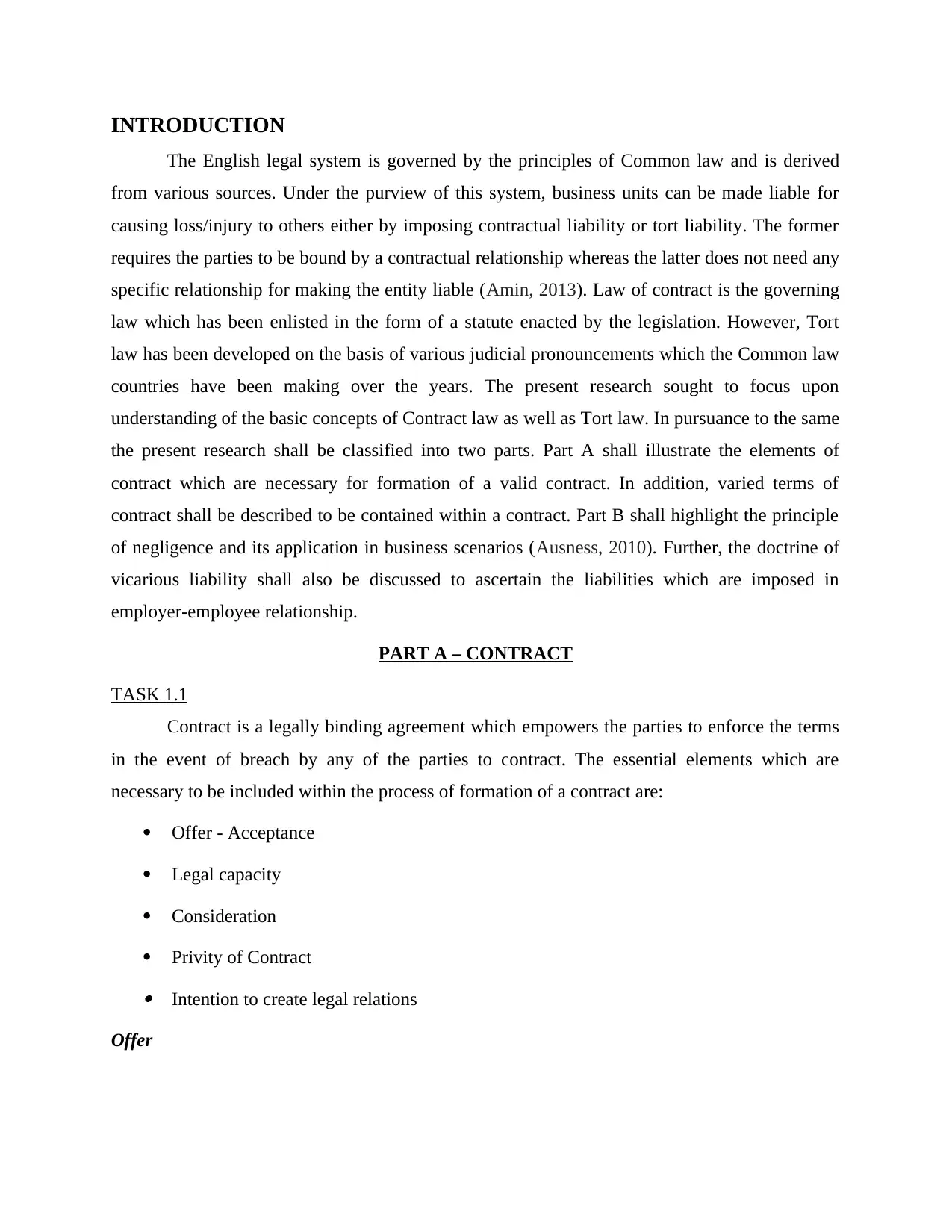
INTRODUCTION
The English legal system is governed by the principles of Common law and is derived
from various sources. Under the purview of this system, business units can be made liable for
causing loss/injury to others either by imposing contractual liability or tort liability. The former
requires the parties to be bound by a contractual relationship whereas the latter does not need any
specific relationship for making the entity liable (Amin, 2013). Law of contract is the governing
law which has been enlisted in the form of a statute enacted by the legislation. However, Tort
law has been developed on the basis of various judicial pronouncements which the Common law
countries have been making over the years. The present research sought to focus upon
understanding of the basic concepts of Contract law as well as Tort law. In pursuance to the same
the present research shall be classified into two parts. Part A shall illustrate the elements of
contract which are necessary for formation of a valid contract. In addition, varied terms of
contract shall be described to be contained within a contract. Part B shall highlight the principle
of negligence and its application in business scenarios (Ausness, 2010). Further, the doctrine of
vicarious liability shall also be discussed to ascertain the liabilities which are imposed in
employer-employee relationship.
PART A – CONTRACT
TASK 1.1
Contract is a legally binding agreement which empowers the parties to enforce the terms
in the event of breach by any of the parties to contract. The essential elements which are
necessary to be included within the process of formation of a contract are:
Offer - Acceptance
Legal capacity
Consideration
Privity of Contract Intention to create legal relations
Offer
The English legal system is governed by the principles of Common law and is derived
from various sources. Under the purview of this system, business units can be made liable for
causing loss/injury to others either by imposing contractual liability or tort liability. The former
requires the parties to be bound by a contractual relationship whereas the latter does not need any
specific relationship for making the entity liable (Amin, 2013). Law of contract is the governing
law which has been enlisted in the form of a statute enacted by the legislation. However, Tort
law has been developed on the basis of various judicial pronouncements which the Common law
countries have been making over the years. The present research sought to focus upon
understanding of the basic concepts of Contract law as well as Tort law. In pursuance to the same
the present research shall be classified into two parts. Part A shall illustrate the elements of
contract which are necessary for formation of a valid contract. In addition, varied terms of
contract shall be described to be contained within a contract. Part B shall highlight the principle
of negligence and its application in business scenarios (Ausness, 2010). Further, the doctrine of
vicarious liability shall also be discussed to ascertain the liabilities which are imposed in
employer-employee relationship.
PART A – CONTRACT
TASK 1.1
Contract is a legally binding agreement which empowers the parties to enforce the terms
in the event of breach by any of the parties to contract. The essential elements which are
necessary to be included within the process of formation of a contract are:
Offer - Acceptance
Legal capacity
Consideration
Privity of Contract Intention to create legal relations
Offer
Paraphrase This Document
Need a fresh take? Get an instant paraphrase of this document with our AI Paraphraser
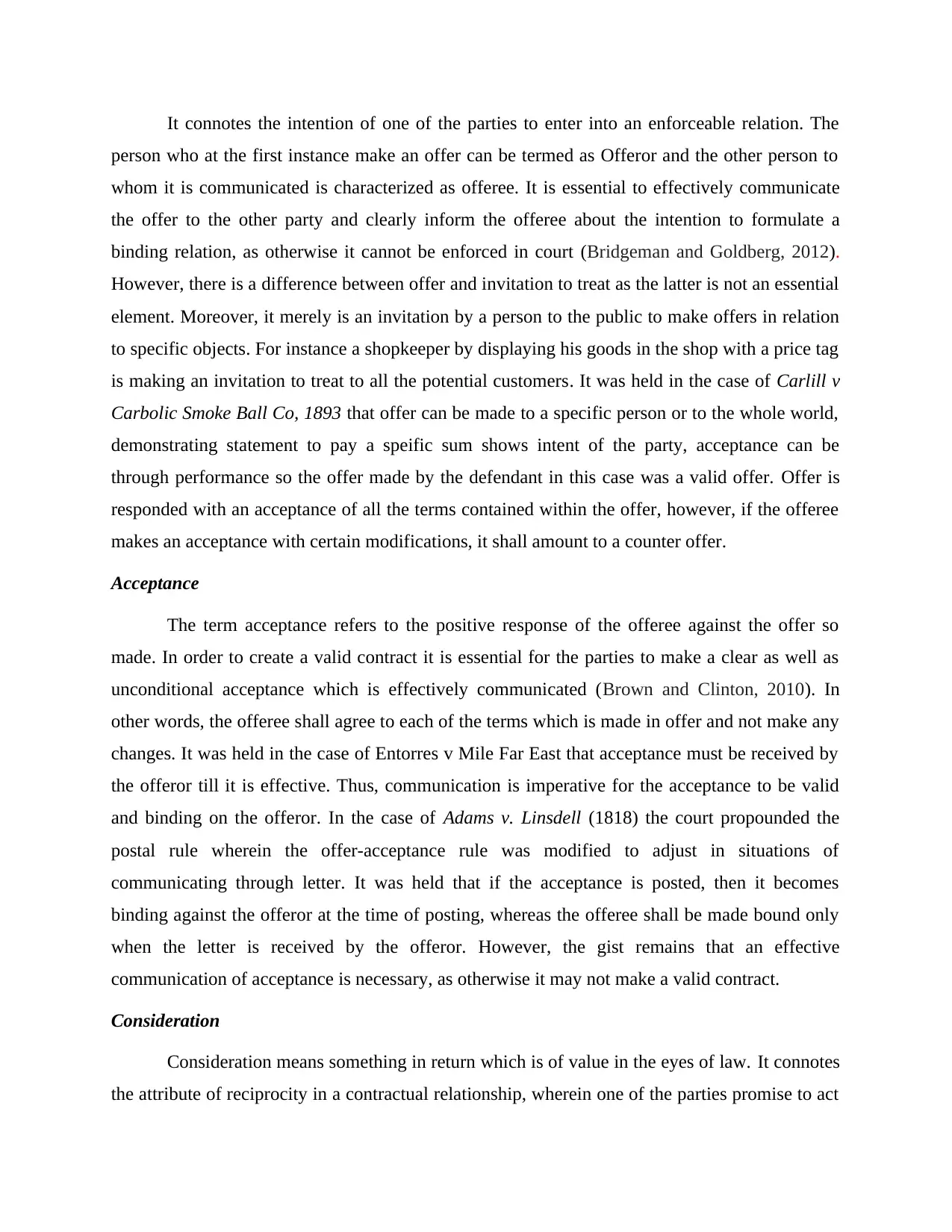
It connotes the intention of one of the parties to enter into an enforceable relation. The
person who at the first instance make an offer can be termed as Offeror and the other person to
whom it is communicated is characterized as offeree. It is essential to effectively communicate
the offer to the other party and clearly inform the offeree about the intention to formulate a
binding relation, as otherwise it cannot be enforced in court (Bridgeman and Goldberg, 2012).
However, there is a difference between offer and invitation to treat as the latter is not an essential
element. Moreover, it merely is an invitation by a person to the public to make offers in relation
to specific objects. For instance a shopkeeper by displaying his goods in the shop with a price tag
is making an invitation to treat to all the potential customers. It was held in the case of Carlill v
Carbolic Smoke Ball Co, 1893 that offer can be made to a specific person or to the whole world,
demonstrating statement to pay a speific sum shows intent of the party, acceptance can be
through performance so the offer made by the defendant in this case was a valid offer. Offer is
responded with an acceptance of all the terms contained within the offer, however, if the offeree
makes an acceptance with certain modifications, it shall amount to a counter offer.
Acceptance
The term acceptance refers to the positive response of the offeree against the offer so
made. In order to create a valid contract it is essential for the parties to make a clear as well as
unconditional acceptance which is effectively communicated (Brown and Clinton, 2010). In
other words, the offeree shall agree to each of the terms which is made in offer and not make any
changes. It was held in the case of Entorres v Mile Far East that acceptance must be received by
the offeror till it is effective. Thus, communication is imperative for the acceptance to be valid
and binding on the offeror. In the case of Adams v. Linsdell (1818) the court propounded the
postal rule wherein the offer-acceptance rule was modified to adjust in situations of
communicating through letter. It was held that if the acceptance is posted, then it becomes
binding against the offeror at the time of posting, whereas the offeree shall be made bound only
when the letter is received by the offeror. However, the gist remains that an effective
communication of acceptance is necessary, as otherwise it may not make a valid contract.
Consideration
Consideration means something in return which is of value in the eyes of law. It connotes
the attribute of reciprocity in a contractual relationship, wherein one of the parties promise to act
person who at the first instance make an offer can be termed as Offeror and the other person to
whom it is communicated is characterized as offeree. It is essential to effectively communicate
the offer to the other party and clearly inform the offeree about the intention to formulate a
binding relation, as otherwise it cannot be enforced in court (Bridgeman and Goldberg, 2012).
However, there is a difference between offer and invitation to treat as the latter is not an essential
element. Moreover, it merely is an invitation by a person to the public to make offers in relation
to specific objects. For instance a shopkeeper by displaying his goods in the shop with a price tag
is making an invitation to treat to all the potential customers. It was held in the case of Carlill v
Carbolic Smoke Ball Co, 1893 that offer can be made to a specific person or to the whole world,
demonstrating statement to pay a speific sum shows intent of the party, acceptance can be
through performance so the offer made by the defendant in this case was a valid offer. Offer is
responded with an acceptance of all the terms contained within the offer, however, if the offeree
makes an acceptance with certain modifications, it shall amount to a counter offer.
Acceptance
The term acceptance refers to the positive response of the offeree against the offer so
made. In order to create a valid contract it is essential for the parties to make a clear as well as
unconditional acceptance which is effectively communicated (Brown and Clinton, 2010). In
other words, the offeree shall agree to each of the terms which is made in offer and not make any
changes. It was held in the case of Entorres v Mile Far East that acceptance must be received by
the offeror till it is effective. Thus, communication is imperative for the acceptance to be valid
and binding on the offeror. In the case of Adams v. Linsdell (1818) the court propounded the
postal rule wherein the offer-acceptance rule was modified to adjust in situations of
communicating through letter. It was held that if the acceptance is posted, then it becomes
binding against the offeror at the time of posting, whereas the offeree shall be made bound only
when the letter is received by the offeror. However, the gist remains that an effective
communication of acceptance is necessary, as otherwise it may not make a valid contract.
Consideration
Consideration means something in return which is of value in the eyes of law. It connotes
the attribute of reciprocity in a contractual relationship, wherein one of the parties promise to act
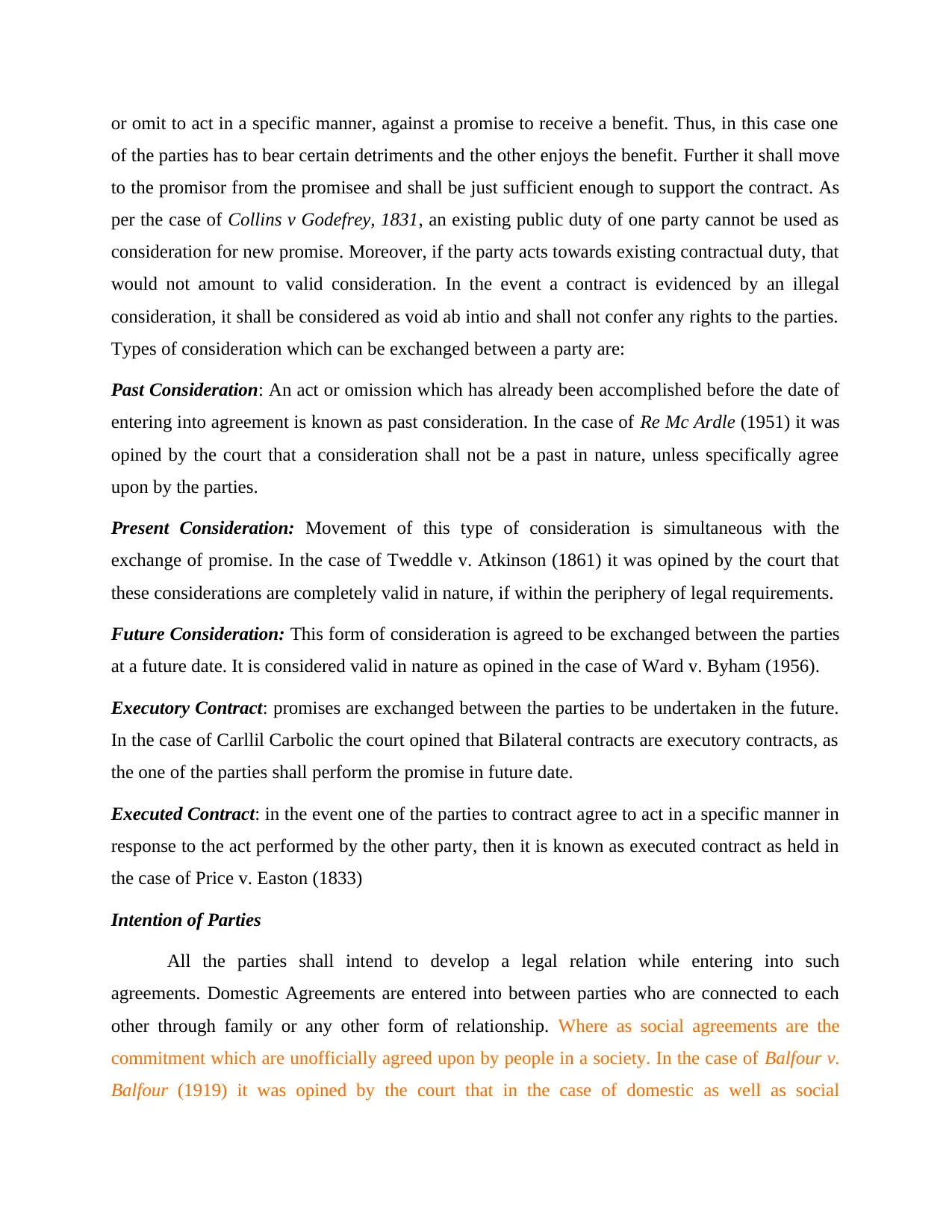
or omit to act in a specific manner, against a promise to receive a benefit. Thus, in this case one
of the parties has to bear certain detriments and the other enjoys the benefit. Further it shall move
to the promisor from the promisee and shall be just sufficient enough to support the contract. As
per the case of Collins v Godefrey, 1831, an existing public duty of one party cannot be used as
consideration for new promise. Moreover, if the party acts towards existing contractual duty, that
would not amount to valid consideration. In the event a contract is evidenced by an illegal
consideration, it shall be considered as void ab intio and shall not confer any rights to the parties.
Types of consideration which can be exchanged between a party are:
Past Consideration: An act or omission which has already been accomplished before the date of
entering into agreement is known as past consideration. In the case of Re Mc Ardle (1951) it was
opined by the court that a consideration shall not be a past in nature, unless specifically agree
upon by the parties.
Present Consideration: Movement of this type of consideration is simultaneous with the
exchange of promise. In the case of Tweddle v. Atkinson (1861) it was opined by the court that
these considerations are completely valid in nature, if within the periphery of legal requirements.
Future Consideration: This form of consideration is agreed to be exchanged between the parties
at a future date. It is considered valid in nature as opined in the case of Ward v. Byham (1956).
Executory Contract: promises are exchanged between the parties to be undertaken in the future.
In the case of Carllil Carbolic the court opined that Bilateral contracts are executory contracts, as
the one of the parties shall perform the promise in future date.
Executed Contract: in the event one of the parties to contract agree to act in a specific manner in
response to the act performed by the other party, then it is known as executed contract as held in
the case of Price v. Easton (1833)
Intention of Parties
All the parties shall intend to develop a legal relation while entering into such
agreements. Domestic Agreements are entered into between parties who are connected to each
other through family or any other form of relationship. Where as social agreements are the
commitment which are unofficially agreed upon by people in a society. In the case of Balfour v.
Balfour (1919) it was opined by the court that in the case of domestic as well as social
of the parties has to bear certain detriments and the other enjoys the benefit. Further it shall move
to the promisor from the promisee and shall be just sufficient enough to support the contract. As
per the case of Collins v Godefrey, 1831, an existing public duty of one party cannot be used as
consideration for new promise. Moreover, if the party acts towards existing contractual duty, that
would not amount to valid consideration. In the event a contract is evidenced by an illegal
consideration, it shall be considered as void ab intio and shall not confer any rights to the parties.
Types of consideration which can be exchanged between a party are:
Past Consideration: An act or omission which has already been accomplished before the date of
entering into agreement is known as past consideration. In the case of Re Mc Ardle (1951) it was
opined by the court that a consideration shall not be a past in nature, unless specifically agree
upon by the parties.
Present Consideration: Movement of this type of consideration is simultaneous with the
exchange of promise. In the case of Tweddle v. Atkinson (1861) it was opined by the court that
these considerations are completely valid in nature, if within the periphery of legal requirements.
Future Consideration: This form of consideration is agreed to be exchanged between the parties
at a future date. It is considered valid in nature as opined in the case of Ward v. Byham (1956).
Executory Contract: promises are exchanged between the parties to be undertaken in the future.
In the case of Carllil Carbolic the court opined that Bilateral contracts are executory contracts, as
the one of the parties shall perform the promise in future date.
Executed Contract: in the event one of the parties to contract agree to act in a specific manner in
response to the act performed by the other party, then it is known as executed contract as held in
the case of Price v. Easton (1833)
Intention of Parties
All the parties shall intend to develop a legal relation while entering into such
agreements. Domestic Agreements are entered into between parties who are connected to each
other through family or any other form of relationship. Where as social agreements are the
commitment which are unofficially agreed upon by people in a society. In the case of Balfour v.
Balfour (1919) it was opined by the court that in the case of domestic as well as social
⊘ This is a preview!⊘
Do you want full access?
Subscribe today to unlock all pages.

Trusted by 1+ million students worldwide
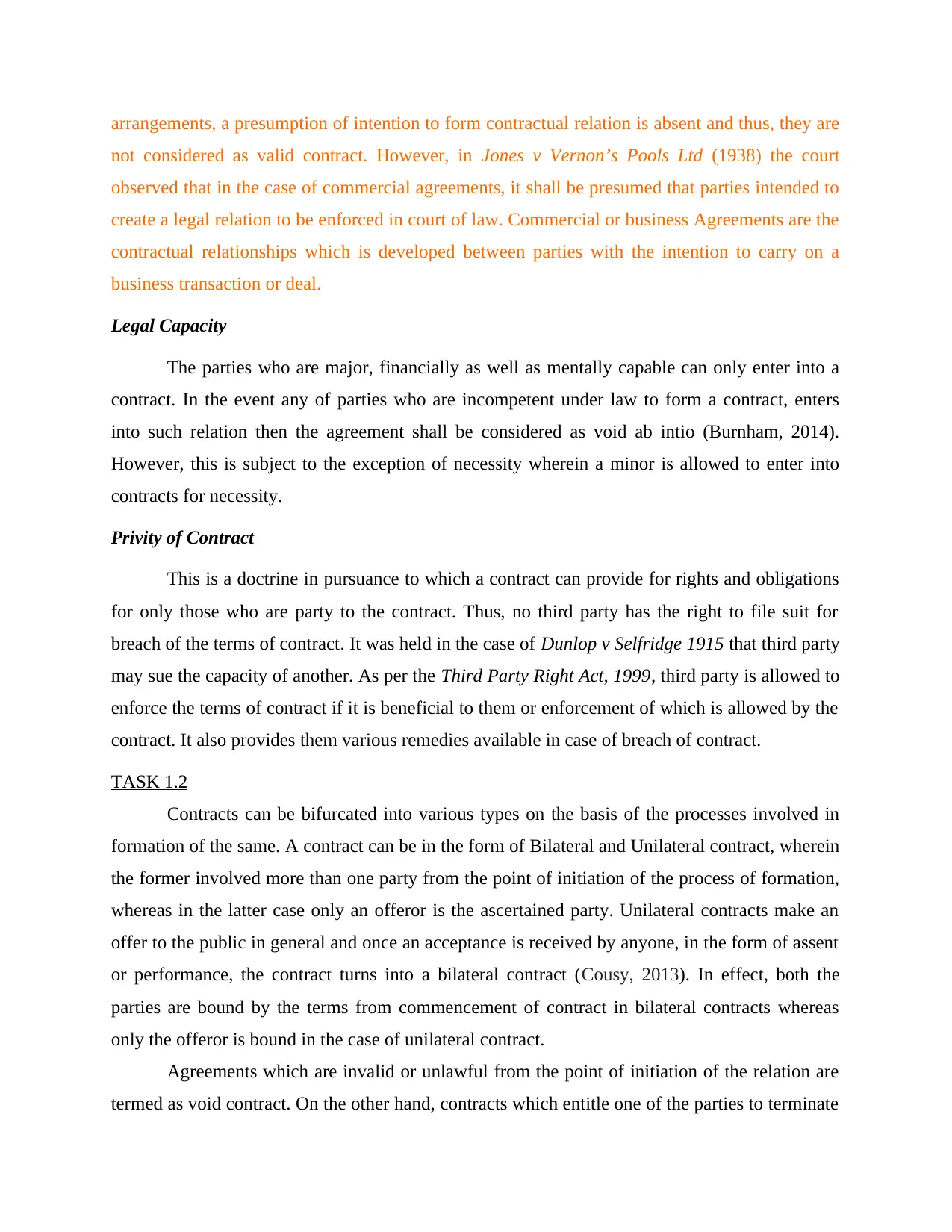
arrangements, a presumption of intention to form contractual relation is absent and thus, they are
not considered as valid contract. However, in Jones v Vernon’s Pools Ltd (1938) the court
observed that in the case of commercial agreements, it shall be presumed that parties intended to
create a legal relation to be enforced in court of law. Commercial or business Agreements are the
contractual relationships which is developed between parties with the intention to carry on a
business transaction or deal.
Legal Capacity
The parties who are major, financially as well as mentally capable can only enter into a
contract. In the event any of parties who are incompetent under law to form a contract, enters
into such relation then the agreement shall be considered as void ab intio (Burnham, 2014).
However, this is subject to the exception of necessity wherein a minor is allowed to enter into
contracts for necessity.
Privity of Contract
This is a doctrine in pursuance to which a contract can provide for rights and obligations
for only those who are party to the contract. Thus, no third party has the right to file suit for
breach of the terms of contract. It was held in the case of Dunlop v Selfridge 1915 that third party
may sue the capacity of another. As per the Third Party Right Act, 1999, third party is allowed to
enforce the terms of contract if it is beneficial to them or enforcement of which is allowed by the
contract. It also provides them various remedies available in case of breach of contract.
TASK 1.2
Contracts can be bifurcated into various types on the basis of the processes involved in
formation of the same. A contract can be in the form of Bilateral and Unilateral contract, wherein
the former involved more than one party from the point of initiation of the process of formation,
whereas in the latter case only an offeror is the ascertained party. Unilateral contracts make an
offer to the public in general and once an acceptance is received by anyone, in the form of assent
or performance, the contract turns into a bilateral contract (Cousy, 2013). In effect, both the
parties are bound by the terms from commencement of contract in bilateral contracts whereas
only the offeror is bound in the case of unilateral contract.
Agreements which are invalid or unlawful from the point of initiation of the relation are
termed as void contract. On the other hand, contracts which entitle one of the parties to terminate
not considered as valid contract. However, in Jones v Vernon’s Pools Ltd (1938) the court
observed that in the case of commercial agreements, it shall be presumed that parties intended to
create a legal relation to be enforced in court of law. Commercial or business Agreements are the
contractual relationships which is developed between parties with the intention to carry on a
business transaction or deal.
Legal Capacity
The parties who are major, financially as well as mentally capable can only enter into a
contract. In the event any of parties who are incompetent under law to form a contract, enters
into such relation then the agreement shall be considered as void ab intio (Burnham, 2014).
However, this is subject to the exception of necessity wherein a minor is allowed to enter into
contracts for necessity.
Privity of Contract
This is a doctrine in pursuance to which a contract can provide for rights and obligations
for only those who are party to the contract. Thus, no third party has the right to file suit for
breach of the terms of contract. It was held in the case of Dunlop v Selfridge 1915 that third party
may sue the capacity of another. As per the Third Party Right Act, 1999, third party is allowed to
enforce the terms of contract if it is beneficial to them or enforcement of which is allowed by the
contract. It also provides them various remedies available in case of breach of contract.
TASK 1.2
Contracts can be bifurcated into various types on the basis of the processes involved in
formation of the same. A contract can be in the form of Bilateral and Unilateral contract, wherein
the former involved more than one party from the point of initiation of the process of formation,
whereas in the latter case only an offeror is the ascertained party. Unilateral contracts make an
offer to the public in general and once an acceptance is received by anyone, in the form of assent
or performance, the contract turns into a bilateral contract (Cousy, 2013). In effect, both the
parties are bound by the terms from commencement of contract in bilateral contracts whereas
only the offeror is bound in the case of unilateral contract.
Agreements which are invalid or unlawful from the point of initiation of the relation are
termed as void contract. On the other hand, contracts which entitle one of the parties to terminate
Paraphrase This Document
Need a fresh take? Get an instant paraphrase of this document with our AI Paraphraser
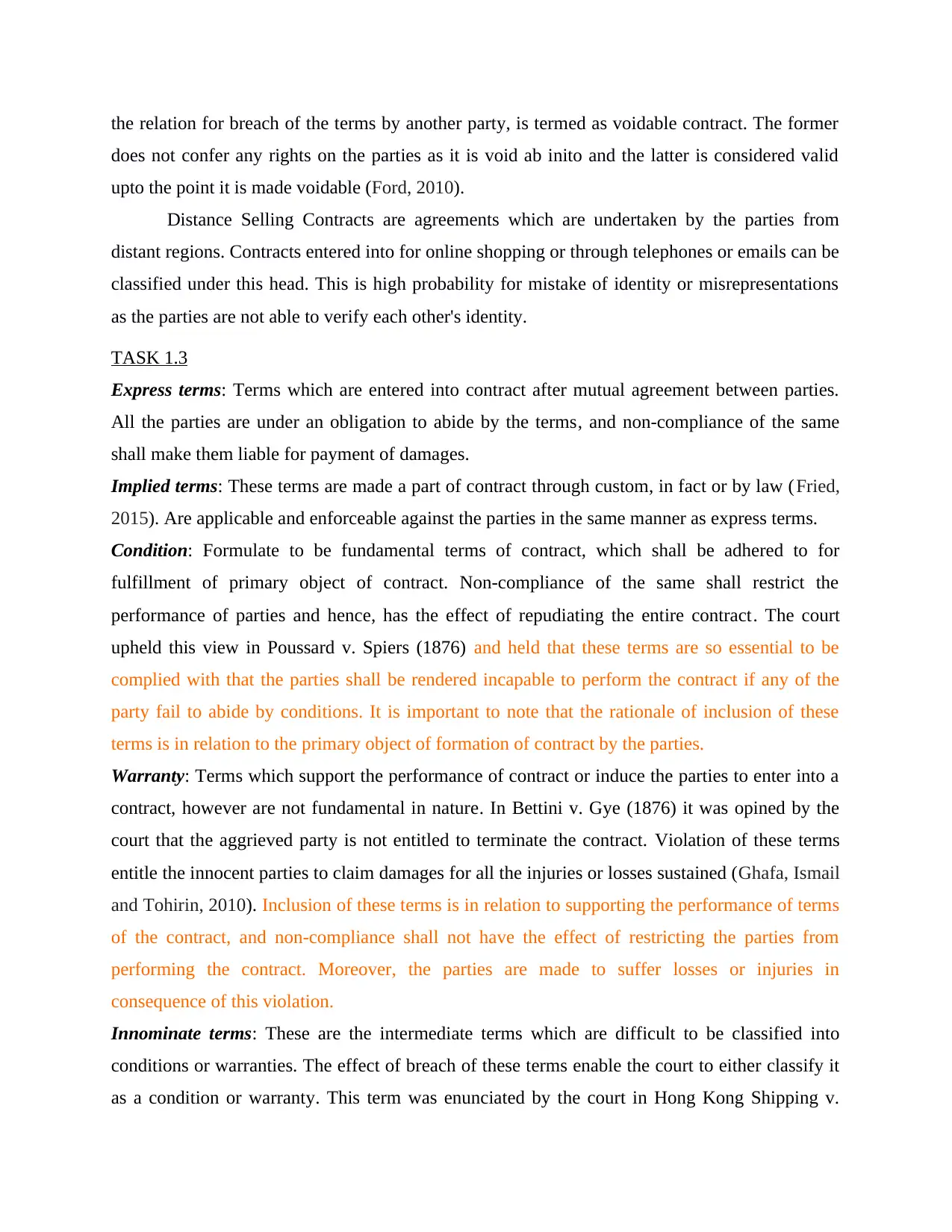
the relation for breach of the terms by another party, is termed as voidable contract. The former
does not confer any rights on the parties as it is void ab inito and the latter is considered valid
upto the point it is made voidable (Ford, 2010).
Distance Selling Contracts are agreements which are undertaken by the parties from
distant regions. Contracts entered into for online shopping or through telephones or emails can be
classified under this head. This is high probability for mistake of identity or misrepresentations
as the parties are not able to verify each other's identity.
TASK 1.3
Express terms: Terms which are entered into contract after mutual agreement between parties.
All the parties are under an obligation to abide by the terms, and non-compliance of the same
shall make them liable for payment of damages.
Implied terms: These terms are made a part of contract through custom, in fact or by law (Fried,
2015). Are applicable and enforceable against the parties in the same manner as express terms.
Condition: Formulate to be fundamental terms of contract, which shall be adhered to for
fulfillment of primary object of contract. Non-compliance of the same shall restrict the
performance of parties and hence, has the effect of repudiating the entire contract. The court
upheld this view in Poussard v. Spiers (1876) and held that these terms are so essential to be
complied with that the parties shall be rendered incapable to perform the contract if any of the
party fail to abide by conditions. It is important to note that the rationale of inclusion of these
terms is in relation to the primary object of formation of contract by the parties.
Warranty: Terms which support the performance of contract or induce the parties to enter into a
contract, however are not fundamental in nature. In Bettini v. Gye (1876) it was opined by the
court that the aggrieved party is not entitled to terminate the contract. Violation of these terms
entitle the innocent parties to claim damages for all the injuries or losses sustained (Ghafa, Ismail
and Tohirin, 2010). Inclusion of these terms is in relation to supporting the performance of terms
of the contract, and non-compliance shall not have the effect of restricting the parties from
performing the contract. Moreover, the parties are made to suffer losses or injuries in
consequence of this violation.
Innominate terms: These are the intermediate terms which are difficult to be classified into
conditions or warranties. The effect of breach of these terms enable the court to either classify it
as a condition or warranty. This term was enunciated by the court in Hong Kong Shipping v.
does not confer any rights on the parties as it is void ab inito and the latter is considered valid
upto the point it is made voidable (Ford, 2010).
Distance Selling Contracts are agreements which are undertaken by the parties from
distant regions. Contracts entered into for online shopping or through telephones or emails can be
classified under this head. This is high probability for mistake of identity or misrepresentations
as the parties are not able to verify each other's identity.
TASK 1.3
Express terms: Terms which are entered into contract after mutual agreement between parties.
All the parties are under an obligation to abide by the terms, and non-compliance of the same
shall make them liable for payment of damages.
Implied terms: These terms are made a part of contract through custom, in fact or by law (Fried,
2015). Are applicable and enforceable against the parties in the same manner as express terms.
Condition: Formulate to be fundamental terms of contract, which shall be adhered to for
fulfillment of primary object of contract. Non-compliance of the same shall restrict the
performance of parties and hence, has the effect of repudiating the entire contract. The court
upheld this view in Poussard v. Spiers (1876) and held that these terms are so essential to be
complied with that the parties shall be rendered incapable to perform the contract if any of the
party fail to abide by conditions. It is important to note that the rationale of inclusion of these
terms is in relation to the primary object of formation of contract by the parties.
Warranty: Terms which support the performance of contract or induce the parties to enter into a
contract, however are not fundamental in nature. In Bettini v. Gye (1876) it was opined by the
court that the aggrieved party is not entitled to terminate the contract. Violation of these terms
entitle the innocent parties to claim damages for all the injuries or losses sustained (Ghafa, Ismail
and Tohirin, 2010). Inclusion of these terms is in relation to supporting the performance of terms
of the contract, and non-compliance shall not have the effect of restricting the parties from
performing the contract. Moreover, the parties are made to suffer losses or injuries in
consequence of this violation.
Innominate terms: These are the intermediate terms which are difficult to be classified into
conditions or warranties. The effect of breach of these terms enable the court to either classify it
as a condition or warranty. This term was enunciated by the court in Hong Kong Shipping v.
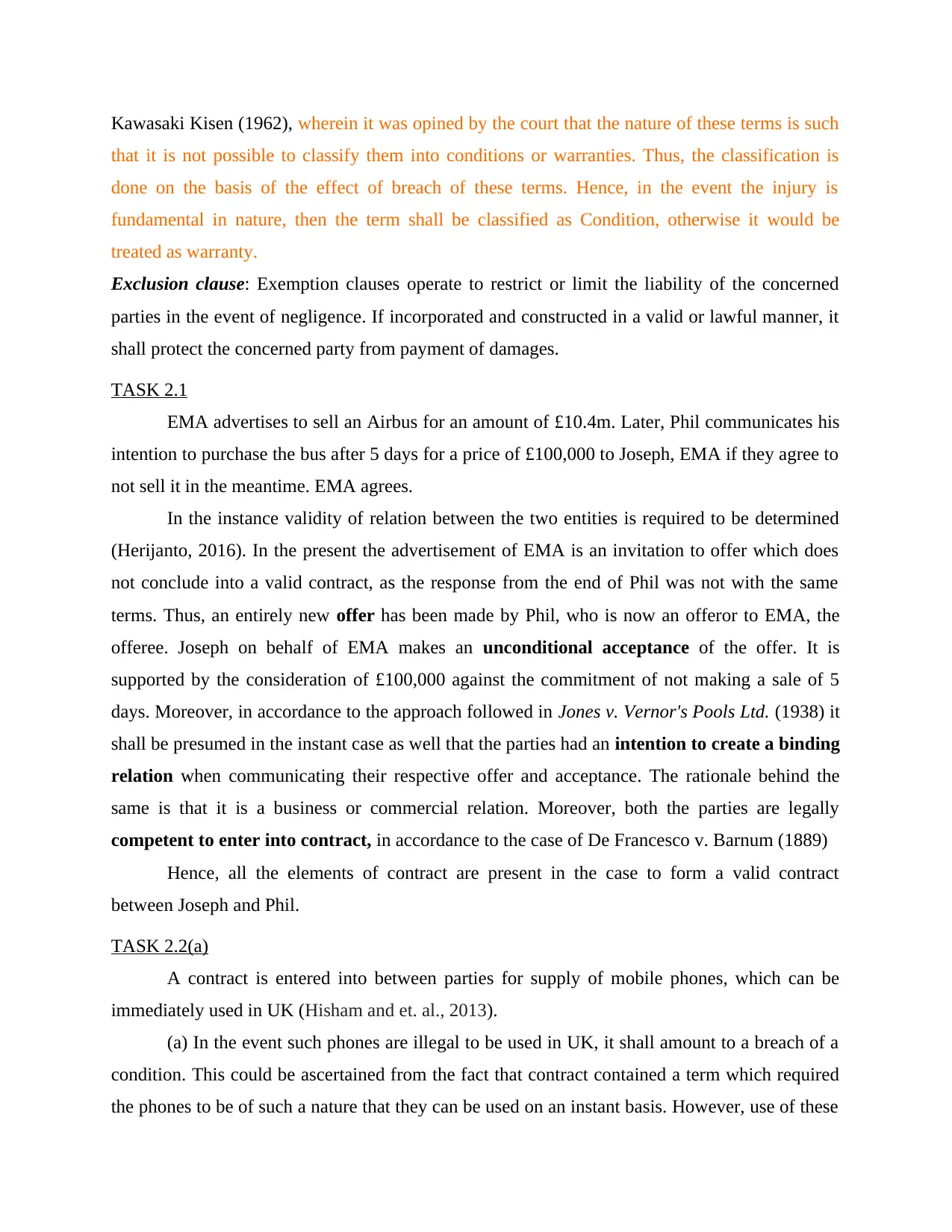
Kawasaki Kisen (1962), wherein it was opined by the court that the nature of these terms is such
that it is not possible to classify them into conditions or warranties. Thus, the classification is
done on the basis of the effect of breach of these terms. Hence, in the event the injury is
fundamental in nature, then the term shall be classified as Condition, otherwise it would be
treated as warranty.
Exclusion clause: Exemption clauses operate to restrict or limit the liability of the concerned
parties in the event of negligence. If incorporated and constructed in a valid or lawful manner, it
shall protect the concerned party from payment of damages.
TASK 2.1
EMA advertises to sell an Airbus for an amount of £10.4m. Later, Phil communicates his
intention to purchase the bus after 5 days for a price of £100,000 to Joseph, EMA if they agree to
not sell it in the meantime. EMA agrees.
In the instance validity of relation between the two entities is required to be determined
(Herijanto, 2016). In the present the advertisement of EMA is an invitation to offer which does
not conclude into a valid contract, as the response from the end of Phil was not with the same
terms. Thus, an entirely new offer has been made by Phil, who is now an offeror to EMA, the
offeree. Joseph on behalf of EMA makes an unconditional acceptance of the offer. It is
supported by the consideration of £100,000 against the commitment of not making a sale of 5
days. Moreover, in accordance to the approach followed in Jones v. Vernor's Pools Ltd. (1938) it
shall be presumed in the instant case as well that the parties had an intention to create a binding
relation when communicating their respective offer and acceptance. The rationale behind the
same is that it is a business or commercial relation. Moreover, both the parties are legally
competent to enter into contract, in accordance to the case of De Francesco v. Barnum (1889)
Hence, all the elements of contract are present in the case to form a valid contract
between Joseph and Phil.
TASK 2.2(a)
A contract is entered into between parties for supply of mobile phones, which can be
immediately used in UK (Hisham and et. al., 2013).
(a) In the event such phones are illegal to be used in UK, it shall amount to a breach of a
condition. This could be ascertained from the fact that contract contained a term which required
the phones to be of such a nature that they can be used on an instant basis. However, use of these
that it is not possible to classify them into conditions or warranties. Thus, the classification is
done on the basis of the effect of breach of these terms. Hence, in the event the injury is
fundamental in nature, then the term shall be classified as Condition, otherwise it would be
treated as warranty.
Exclusion clause: Exemption clauses operate to restrict or limit the liability of the concerned
parties in the event of negligence. If incorporated and constructed in a valid or lawful manner, it
shall protect the concerned party from payment of damages.
TASK 2.1
EMA advertises to sell an Airbus for an amount of £10.4m. Later, Phil communicates his
intention to purchase the bus after 5 days for a price of £100,000 to Joseph, EMA if they agree to
not sell it in the meantime. EMA agrees.
In the instance validity of relation between the two entities is required to be determined
(Herijanto, 2016). In the present the advertisement of EMA is an invitation to offer which does
not conclude into a valid contract, as the response from the end of Phil was not with the same
terms. Thus, an entirely new offer has been made by Phil, who is now an offeror to EMA, the
offeree. Joseph on behalf of EMA makes an unconditional acceptance of the offer. It is
supported by the consideration of £100,000 against the commitment of not making a sale of 5
days. Moreover, in accordance to the approach followed in Jones v. Vernor's Pools Ltd. (1938) it
shall be presumed in the instant case as well that the parties had an intention to create a binding
relation when communicating their respective offer and acceptance. The rationale behind the
same is that it is a business or commercial relation. Moreover, both the parties are legally
competent to enter into contract, in accordance to the case of De Francesco v. Barnum (1889)
Hence, all the elements of contract are present in the case to form a valid contract
between Joseph and Phil.
TASK 2.2(a)
A contract is entered into between parties for supply of mobile phones, which can be
immediately used in UK (Hisham and et. al., 2013).
(a) In the event such phones are illegal to be used in UK, it shall amount to a breach of a
condition. This could be ascertained from the fact that contract contained a term which required
the phones to be of such a nature that they can be used on an instant basis. However, use of these
⊘ This is a preview!⊘
Do you want full access?
Subscribe today to unlock all pages.

Trusted by 1+ million students worldwide
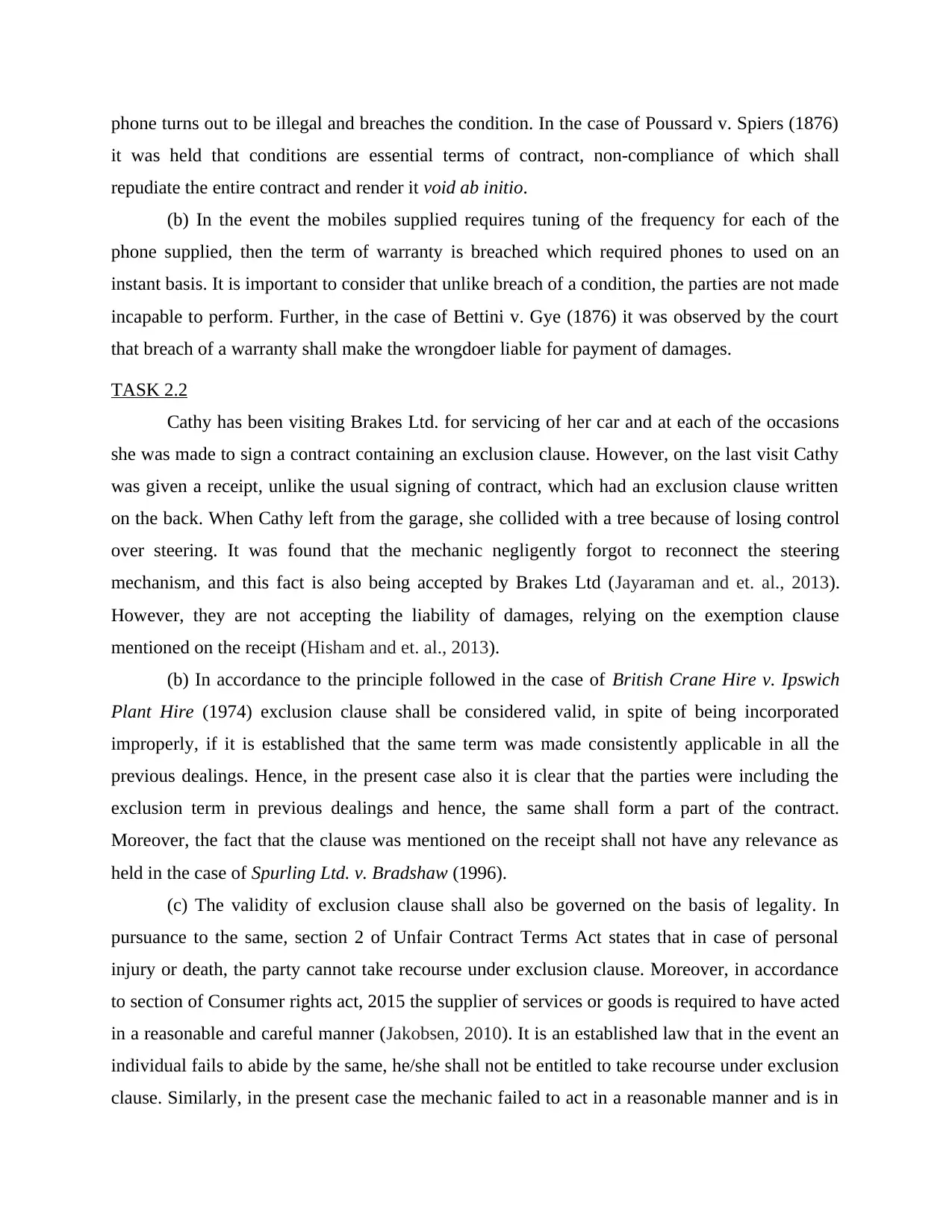
phone turns out to be illegal and breaches the condition. In the case of Poussard v. Spiers (1876)
it was held that conditions are essential terms of contract, non-compliance of which shall
repudiate the entire contract and render it void ab initio.
(b) In the event the mobiles supplied requires tuning of the frequency for each of the
phone supplied, then the term of warranty is breached which required phones to used on an
instant basis. It is important to consider that unlike breach of a condition, the parties are not made
incapable to perform. Further, in the case of Bettini v. Gye (1876) it was observed by the court
that breach of a warranty shall make the wrongdoer liable for payment of damages.
TASK 2.2
Cathy has been visiting Brakes Ltd. for servicing of her car and at each of the occasions
she was made to sign a contract containing an exclusion clause. However, on the last visit Cathy
was given a receipt, unlike the usual signing of contract, which had an exclusion clause written
on the back. When Cathy left from the garage, she collided with a tree because of losing control
over steering. It was found that the mechanic negligently forgot to reconnect the steering
mechanism, and this fact is also being accepted by Brakes Ltd (Jayaraman and et. al., 2013).
However, they are not accepting the liability of damages, relying on the exemption clause
mentioned on the receipt (Hisham and et. al., 2013).
(b) In accordance to the principle followed in the case of British Crane Hire v. Ipswich
Plant Hire (1974) exclusion clause shall be considered valid, in spite of being incorporated
improperly, if it is established that the same term was made consistently applicable in all the
previous dealings. Hence, in the present case also it is clear that the parties were including the
exclusion term in previous dealings and hence, the same shall form a part of the contract.
Moreover, the fact that the clause was mentioned on the receipt shall not have any relevance as
held in the case of Spurling Ltd. v. Bradshaw (1996).
(c) The validity of exclusion clause shall also be governed on the basis of legality. In
pursuance to the same, section 2 of Unfair Contract Terms Act states that in case of personal
injury or death, the party cannot take recourse under exclusion clause. Moreover, in accordance
to section of Consumer rights act, 2015 the supplier of services or goods is required to have acted
in a reasonable and careful manner (Jakobsen, 2010). It is an established law that in the event an
individual fails to abide by the same, he/she shall not be entitled to take recourse under exclusion
clause. Similarly, in the present case the mechanic failed to act in a reasonable manner and is in
it was held that conditions are essential terms of contract, non-compliance of which shall
repudiate the entire contract and render it void ab initio.
(b) In the event the mobiles supplied requires tuning of the frequency for each of the
phone supplied, then the term of warranty is breached which required phones to used on an
instant basis. It is important to consider that unlike breach of a condition, the parties are not made
incapable to perform. Further, in the case of Bettini v. Gye (1876) it was observed by the court
that breach of a warranty shall make the wrongdoer liable for payment of damages.
TASK 2.2
Cathy has been visiting Brakes Ltd. for servicing of her car and at each of the occasions
she was made to sign a contract containing an exclusion clause. However, on the last visit Cathy
was given a receipt, unlike the usual signing of contract, which had an exclusion clause written
on the back. When Cathy left from the garage, she collided with a tree because of losing control
over steering. It was found that the mechanic negligently forgot to reconnect the steering
mechanism, and this fact is also being accepted by Brakes Ltd (Jayaraman and et. al., 2013).
However, they are not accepting the liability of damages, relying on the exemption clause
mentioned on the receipt (Hisham and et. al., 2013).
(b) In accordance to the principle followed in the case of British Crane Hire v. Ipswich
Plant Hire (1974) exclusion clause shall be considered valid, in spite of being incorporated
improperly, if it is established that the same term was made consistently applicable in all the
previous dealings. Hence, in the present case also it is clear that the parties were including the
exclusion term in previous dealings and hence, the same shall form a part of the contract.
Moreover, the fact that the clause was mentioned on the receipt shall not have any relevance as
held in the case of Spurling Ltd. v. Bradshaw (1996).
(c) The validity of exclusion clause shall also be governed on the basis of legality. In
pursuance to the same, section 2 of Unfair Contract Terms Act states that in case of personal
injury or death, the party cannot take recourse under exclusion clause. Moreover, in accordance
to section of Consumer rights act, 2015 the supplier of services or goods is required to have acted
in a reasonable and careful manner (Jakobsen, 2010). It is an established law that in the event an
individual fails to abide by the same, he/she shall not be entitled to take recourse under exclusion
clause. Similarly, in the present case the mechanic failed to act in a reasonable manner and is in
Paraphrase This Document
Need a fresh take? Get an instant paraphrase of this document with our AI Paraphraser
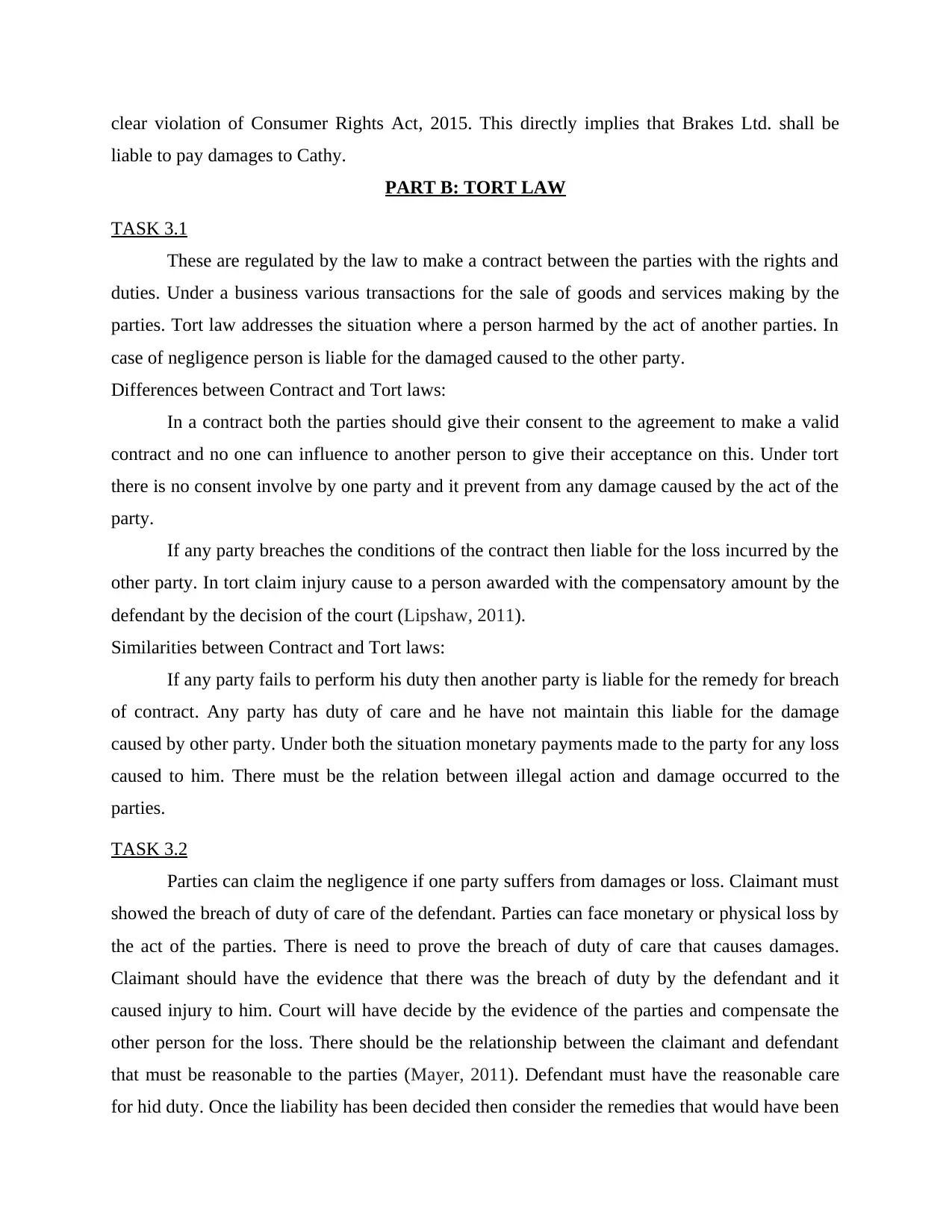
clear violation of Consumer Rights Act, 2015. This directly implies that Brakes Ltd. shall be
liable to pay damages to Cathy.
PART B: TORT LAW
TASK 3.1
These are regulated by the law to make a contract between the parties with the rights and
duties. Under a business various transactions for the sale of goods and services making by the
parties. Tort law addresses the situation where a person harmed by the act of another parties. In
case of negligence person is liable for the damaged caused to the other party.
Differences between Contract and Tort laws:
In a contract both the parties should give their consent to the agreement to make a valid
contract and no one can influence to another person to give their acceptance on this. Under tort
there is no consent involve by one party and it prevent from any damage caused by the act of the
party.
If any party breaches the conditions of the contract then liable for the loss incurred by the
other party. In tort claim injury cause to a person awarded with the compensatory amount by the
defendant by the decision of the court (Lipshaw, 2011).
Similarities between Contract and Tort laws:
If any party fails to perform his duty then another party is liable for the remedy for breach
of contract. Any party has duty of care and he have not maintain this liable for the damage
caused by other party. Under both the situation monetary payments made to the party for any loss
caused to him. There must be the relation between illegal action and damage occurred to the
parties.
TASK 3.2
Parties can claim the negligence if one party suffers from damages or loss. Claimant must
showed the breach of duty of care of the defendant. Parties can face monetary or physical loss by
the act of the parties. There is need to prove the breach of duty of care that causes damages.
Claimant should have the evidence that there was the breach of duty by the defendant and it
caused injury to him. Court will have decide by the evidence of the parties and compensate the
other person for the loss. There should be the relationship between the claimant and defendant
that must be reasonable to the parties (Mayer, 2011). Defendant must have the reasonable care
for hid duty. Once the liability has been decided then consider the remedies that would have been
liable to pay damages to Cathy.
PART B: TORT LAW
TASK 3.1
These are regulated by the law to make a contract between the parties with the rights and
duties. Under a business various transactions for the sale of goods and services making by the
parties. Tort law addresses the situation where a person harmed by the act of another parties. In
case of negligence person is liable for the damaged caused to the other party.
Differences between Contract and Tort laws:
In a contract both the parties should give their consent to the agreement to make a valid
contract and no one can influence to another person to give their acceptance on this. Under tort
there is no consent involve by one party and it prevent from any damage caused by the act of the
party.
If any party breaches the conditions of the contract then liable for the loss incurred by the
other party. In tort claim injury cause to a person awarded with the compensatory amount by the
defendant by the decision of the court (Lipshaw, 2011).
Similarities between Contract and Tort laws:
If any party fails to perform his duty then another party is liable for the remedy for breach
of contract. Any party has duty of care and he have not maintain this liable for the damage
caused by other party. Under both the situation monetary payments made to the party for any loss
caused to him. There must be the relation between illegal action and damage occurred to the
parties.
TASK 3.2
Parties can claim the negligence if one party suffers from damages or loss. Claimant must
showed the breach of duty of care of the defendant. Parties can face monetary or physical loss by
the act of the parties. There is need to prove the breach of duty of care that causes damages.
Claimant should have the evidence that there was the breach of duty by the defendant and it
caused injury to him. Court will have decide by the evidence of the parties and compensate the
other person for the loss. There should be the relationship between the claimant and defendant
that must be reasonable to the parties (Mayer, 2011). Defendant must have the reasonable care
for hid duty. Once the liability has been decided then consider the remedies that would have been
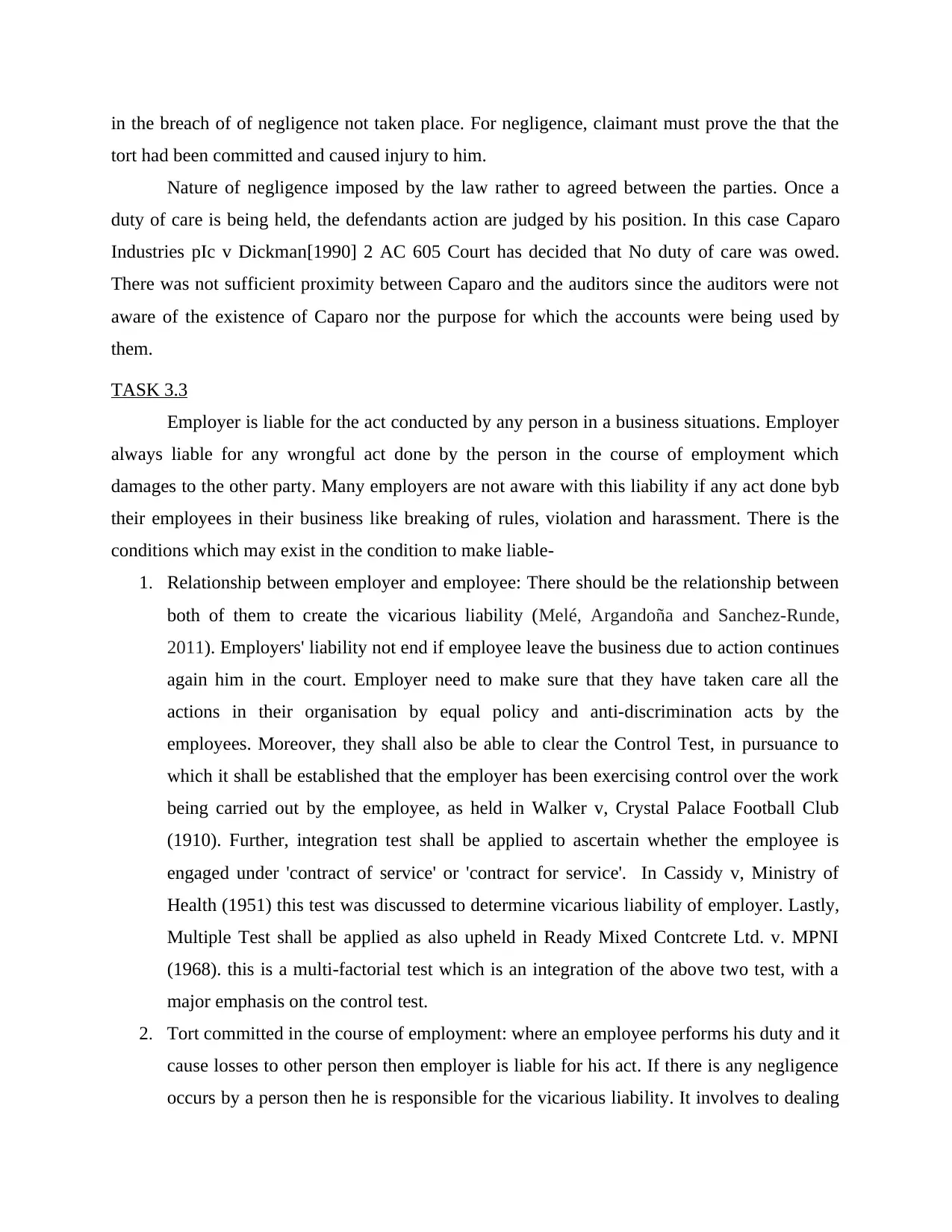
in the breach of of negligence not taken place. For negligence, claimant must prove the that the
tort had been committed and caused injury to him.
Nature of negligence imposed by the law rather to agreed between the parties. Once a
duty of care is being held, the defendants action are judged by his position. In this case Caparo
Industries pIc v Dickman[1990] 2 AC 605 Court has decided that No duty of care was owed.
There was not sufficient proximity between Caparo and the auditors since the auditors were not
aware of the existence of Caparo nor the purpose for which the accounts were being used by
them.
TASK 3.3
Employer is liable for the act conducted by any person in a business situations. Employer
always liable for any wrongful act done by the person in the course of employment which
damages to the other party. Many employers are not aware with this liability if any act done byb
their employees in their business like breaking of rules, violation and harassment. There is the
conditions which may exist in the condition to make liable-
1. Relationship between employer and employee: There should be the relationship between
both of them to create the vicarious liability (Melé, Argandoña and Sanchez-Runde,
2011). Employers' liability not end if employee leave the business due to action continues
again him in the court. Employer need to make sure that they have taken care all the
actions in their organisation by equal policy and anti-discrimination acts by the
employees. Moreover, they shall also be able to clear the Control Test, in pursuance to
which it shall be established that the employer has been exercising control over the work
being carried out by the employee, as held in Walker v, Crystal Palace Football Club
(1910). Further, integration test shall be applied to ascertain whether the employee is
engaged under 'contract of service' or 'contract for service'. In Cassidy v, Ministry of
Health (1951) this test was discussed to determine vicarious liability of employer. Lastly,
Multiple Test shall be applied as also upheld in Ready Mixed Contcrete Ltd. v. MPNI
(1968). this is a multi-factorial test which is an integration of the above two test, with a
major emphasis on the control test.
2. Tort committed in the course of employment: where an employee performs his duty and it
cause losses to other person then employer is liable for his act. If there is any negligence
occurs by a person then he is responsible for the vicarious liability. It involves to dealing
tort had been committed and caused injury to him.
Nature of negligence imposed by the law rather to agreed between the parties. Once a
duty of care is being held, the defendants action are judged by his position. In this case Caparo
Industries pIc v Dickman[1990] 2 AC 605 Court has decided that No duty of care was owed.
There was not sufficient proximity between Caparo and the auditors since the auditors were not
aware of the existence of Caparo nor the purpose for which the accounts were being used by
them.
TASK 3.3
Employer is liable for the act conducted by any person in a business situations. Employer
always liable for any wrongful act done by the person in the course of employment which
damages to the other party. Many employers are not aware with this liability if any act done byb
their employees in their business like breaking of rules, violation and harassment. There is the
conditions which may exist in the condition to make liable-
1. Relationship between employer and employee: There should be the relationship between
both of them to create the vicarious liability (Melé, Argandoña and Sanchez-Runde,
2011). Employers' liability not end if employee leave the business due to action continues
again him in the court. Employer need to make sure that they have taken care all the
actions in their organisation by equal policy and anti-discrimination acts by the
employees. Moreover, they shall also be able to clear the Control Test, in pursuance to
which it shall be established that the employer has been exercising control over the work
being carried out by the employee, as held in Walker v, Crystal Palace Football Club
(1910). Further, integration test shall be applied to ascertain whether the employee is
engaged under 'contract of service' or 'contract for service'. In Cassidy v, Ministry of
Health (1951) this test was discussed to determine vicarious liability of employer. Lastly,
Multiple Test shall be applied as also upheld in Ready Mixed Contcrete Ltd. v. MPNI
(1968). this is a multi-factorial test which is an integration of the above two test, with a
major emphasis on the control test.
2. Tort committed in the course of employment: where an employee performs his duty and it
cause losses to other person then employer is liable for his act. If there is any negligence
occurs by a person then he is responsible for the vicarious liability. It involves to dealing
⊘ This is a preview!⊘
Do you want full access?
Subscribe today to unlock all pages.

Trusted by 1+ million students worldwide
1 out of 18
Related Documents
Your All-in-One AI-Powered Toolkit for Academic Success.
+13062052269
info@desklib.com
Available 24*7 on WhatsApp / Email
![[object Object]](/_next/static/media/star-bottom.7253800d.svg)
Unlock your academic potential
Copyright © 2020–2025 A2Z Services. All Rights Reserved. Developed and managed by ZUCOL.





